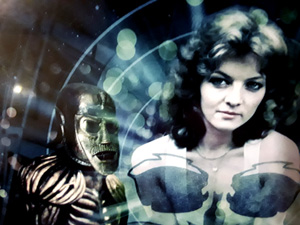Terminus
“This is Terminus, where all the Lazars come to die. We’re on a leper ship!” – Olvir
My very strong memories of this story as a child are of the massive wolf-like Garm, the gruff men in armor needing a drug to stay alive, and the big reveal at the end about Terminus’s role in creating the entire universe. It later became one of my favorite Target novelizations to read and from it I later came to have a deep appreciation for Nyssa’s struggle and sacrifice to stay and fight Lazars disease and the touching near sacrifice of Bor.
The story opens with more reason for Tegan (and us) to be suspicious of Turlough. He never comes across as vile in his manner, so these obvious moments of sabotage help remind us that he is a threat on board the TARDIS. It’s funny to see that his icy sarcasm makes him perhaps the only one who is a match for Tegan’s ire. I also love the scene of her and Nyssa together in their room discussing him as “the brat”. (It’s sad that their chumminess as familiar friends only gets to show itself in these last few stories before Nyssa’s departure.) Interestingly, both his and Tegan’s roles become rather inconsequential to the story over all as their skulking around trapped in the spaceship becomes a kind of throwaway subplot. Nevertheless, they get some nice interaction in which both serves to remind us of Turlough’s divided loyalties as well as show the development of begrudging rapport between him and Tegan–especially their odd but thoughtful discussion on the morality of killing, something which of course for us the audience has an extra layer knowing Turlough’s dilemma.
The action gets into gear with the sudden instability and intrusion of the real world into the TARDIS. The Doctor’s abrupt and perfect chair throwing ability makes for quite a cool moment! As they follow Nyssa through the door, the explanation for its presence and what has actually happened with the TARDIS get a bit murky. (Did the TARDIS create the door? If so, then why does it simply seem to be a part of the ship? If not, why does it disappear?) Either way, I do wish the death’s heads scattered around the ship had been more crudely drawn—looking more like grafitti by desperate passengers on their way to an uncertain future. It does set a great atmosphere when from what seemed an empty ship we start to hearing the groaning and moaning of the seeming dead and the zombie-like hands of the passengers suddenly reach out grabbing Tegan. The hysteria of Olvir definitely lets us know there is a problem, but unfortunately the overzealous high-pitched acting makes what would have been a huge cliffhanger reveal hard to understand. Still, the moment of him being found by Nyssa cowering and obviously reliving a childhood trauma of the loss of his sister is rather touching.
As we move further into the story proper, we are introduced to so many interesting layers. The enslaved Vanir performing a mind-numbing duty they don’t understand, the pitiful Lazar victims treated like chattel, the greed of the company that keeps things going, the surprise that the cure actually might work and no one knows it. The circumstances are bad enough, but it’s quite startling when we start to realize that Nyssa is not just mistaken for a patient but is continued through processing because she does actually have the disease. They do an amazing job with her make-up, just subtly enough showing her a bit paler and more haggard to let us know that it is true.
Nyssa’s journey and the internal power struggle of the Vanir are already enough to propel the story forward but things get even more interesting as we meet poor Bor, driven insane but doggedly trying to save the universe. Even as a child, I remember it seeming so pitiful when he cries out “My wall!” when his obviously useless efforts to block the growing radiation get knocked down. Fortunately, the Doctor realizes that his crazy songs and mutterings are actually forecasting the end of everything and follows this hunch to the crucial scene where he learns that Terminus sits at the center of the universe precisely because it was a fuel explosion of the ship that started entire Big Bang.
We then race towards the end of the story and the desperate need to avoid the explosion. Though his story had not been the focus, I like how they bring it down to the goodness and heart of the Garm that everyone had mistaken as a monster. When he asks to be freed from his slavery, we are briefly given a moment to collectively hold our breaths wondering if the Doctor will dare do it—and he of course he does without a second thought. This follows with the Vanir also being given their opportunity for freedom from the heartless company and finally for Nyssa to find purpose and devote herself to a life of hardship trying to cure the Lazar disease. The final scenes of Nyssa saying goodbye are both sad and touching—from Tegan’s childlike run to the Doctor wanting him to make it better to the Doctor willingly letting her go (“You’re a very brave person.”). It’s a great ending to Nyssa’s story.
Best (or worst) unsettling moment:
The idea that an accidental explosion of radioactive fuel from a space ship created our universe freaked me out as a child. I still hold a sense of wonder at the scene where the Doctor and Kari stand by the ancient alien pilot coming to this realization. It’s not spelled out but I always assumed that this means the pilot and Terminus are from another universe, one that he accidentally destroyed and created a new one.
Regrets:
I could overlook the eighties headbands, but the fishbowl helmets of Olvir and Kari are ridiculous and undermine the seriousness of their roles as raiders.

